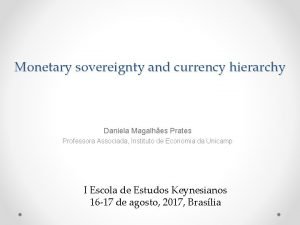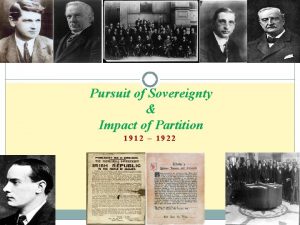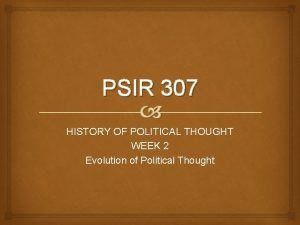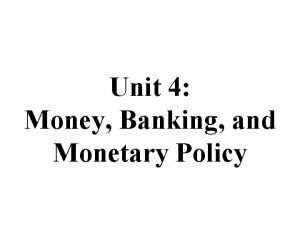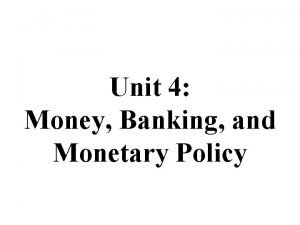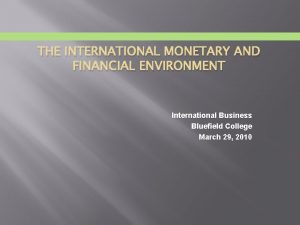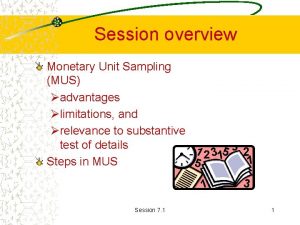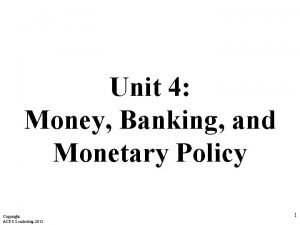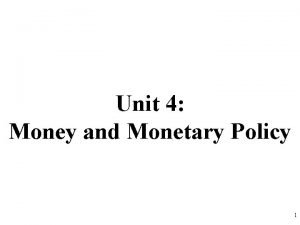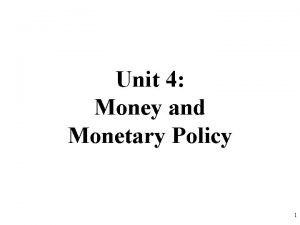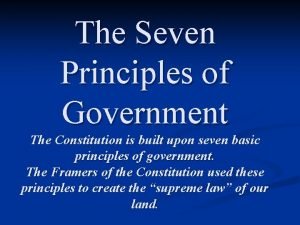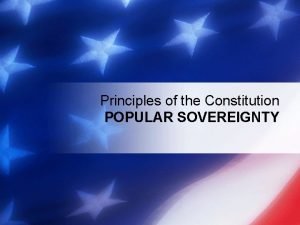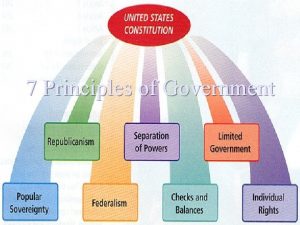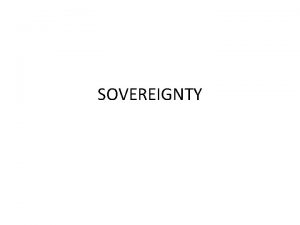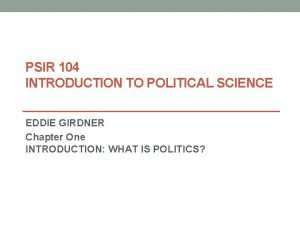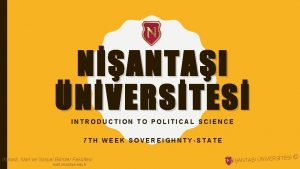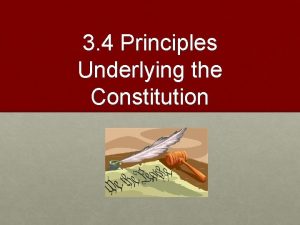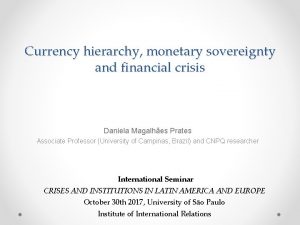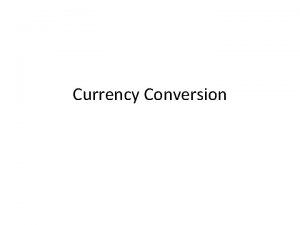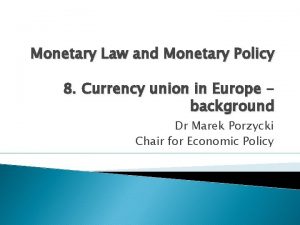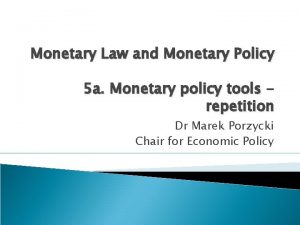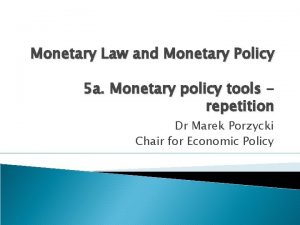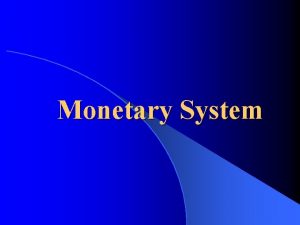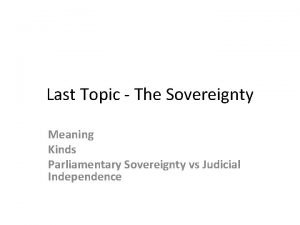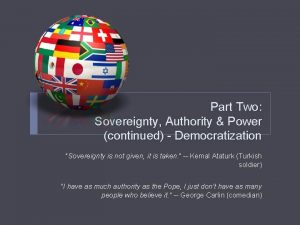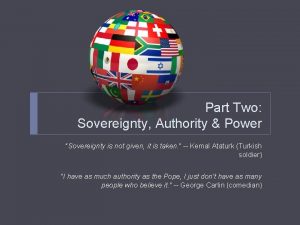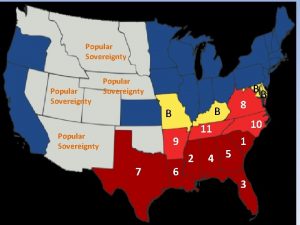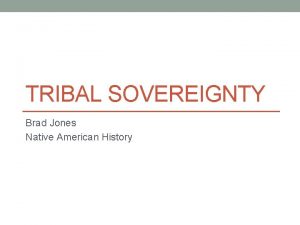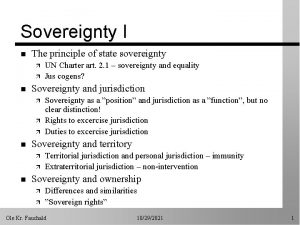Monetary sovereignty and currency hierarchy Daniela Magalhes Prates































- Slides: 31

Monetary sovereignty and currency hierarchy Daniela Magalhães Prates Professora Associada, Instituto de Economia da Unicamp I Escola de Estudos Keynesianos 16 -17 de agosto, 2017, Brasília

Outline 1. Starting point 2. The concept of Monetary Sovereignty o Stricto sensu o Lato sensu 3. Monetary sovereignty, currency hierarchy and policy space: a post-Keynesian approach

1. Starting point • Research agenda on Currency Hierarchy (CH) in the current International Monetary and Financial System (IMFS) (Prates, 2002; Prates, 2005; Andrade & Prates, 2013; Paula, Fritz and Prates, 2017) • Keynesian-structuralist approach • Keynes: IMS based on a key-currency => CH • Center-periphery dimension (ECLAC): a system of uneven partners => asymmetries center X peripheral currencies USD Euro Keynes (1936) TG, cap. 17 Total expect return Other Center currencies Peripheral currencies ra = a + q – c + l l = liquidity premium

1. Starting point • CH => monetary asymmetry • Post-BW: fiduciary and flexible USD + financial globalization => financial asymmetry o Capital flows determined by external factors + Marginal insertion => Financial cycle takers • Monetary + financial asymmetries => higher volatility of capital flows to Emerging Economies (EE) and higher exchange rate volatility o Macroeconomic asymmetry = lower macroeconomic policy autonomy (i. e, policy space) => policy takers USD Euro Center currencies Peripheral Emerging currencies

1. Starting point • Global financial crisis of 2008 • Contagion effect on EE => policy makers/anti-cyclical policies defensive strategies after the 1990’s financial crisis • Euro crisis • Adoption of the euro => ”periphery” climb the CH => lower interest rates and higher growth before the crisis => higher policy space • Crisis => PIIGs forced to adopt pro-cyclical policies => policy takers/loss of policy space o Loss of Monetary Sovereignty (MS)

1. Starting point • Question: what are the advantages and disadvantages of: • Climbing the CH with loss of MS • Increasing the macroeconomic policy autonomy without climbing it (but, which policies? ) • Understanding the relationship among macroeconomic policy autonomy, CH and MS in the current IMFS • Economic literature: focus on one dimension or the interplay of two dimensions • Post-Keynesian approach: neo-chartalism/MMT • French monetary institutionalism • International Political Economy (IPE): power relations between states • Yet, what does monetary sovereignty mean?

2. The concept of MS • “There exists perhaps no conception the meaning of which is more controversial than that of sovereignty (Oppenheim, 1905) • ‘"If sovereignty is one of those concepts that generate intense debates (…) the notion of monetary sovereignty seems to double the handicap. It is rarely defined in the economic literature (Blanc, 2011). • Multi/Interdisciplinary concept: law, economics, politics, anthropology and sociology • Contested concept (Zimmermann, 2003): concept’s nature is essentially dynamic, being subject to constant evolution + positive and normative components

2. The concept of MS • First step: what does sovereignty mean? 1. Political sovereignty 'the state is sovereign' is usually a tautology, just as the expression ‘'sovereign state' can be a pleonasm” (Mundell, 1997) 2. Supreme/absolute power or authority = god(s), church, people, society, community • Not only legal -> Legitimacy, Trust 3. Freedom from external control: autonomy/independence • Second step: what does money mean? • Different approaches on money => different concepts of MS

2. The concept of MS Two classes of concepts • MS in narrower sense => stricto sensu • Political/state sovereignty • MS in broader sense => lato sensu • Encompass political/state sovereignty (stricto sensu) • Sovereignty as o absolute power o autonomy/independence

2. MS: stricto sensu • Monetary sovereignty stricto sensu => legal right of the state to create the national currency • Monetary sovereignty as one dimension of political sovereignty. • 16 th century, Jean Bodin and François Grimaudet o Principle of sovereignty = key foundation for the exercise of state power. • Included the royal prerogative to coin money. • 17 th-century Peace of Westphalia: nation-state celebrated as absolutely sovereign within its own territory, as the basic unit of governance in world politics • 19 th century: territorial currency -> one nation/one money (Helleiner, 2011). • International Court of Justice in 1929: "It is a generally accepted principle that every state has the right to determine its own currencies” • Goodhart (1998): ”In the Euro area, the traditional historical links between money creation and sovereignty will be broken to a unique extent”. • Mainstream economic • Fred Hirsch (1969): ”One of the hallmarks of national sovereignty through the ages has been the right to create money”

2. MS: lato sensu • Monetary sovereignty lato sensu => sovereignty encompass autonomy of monetary and exchange rate policy • Zimmermann (2003): classical understanding of MS: independence from external interference in the management of a state’s monetary affairs • Steil & Hinds (2009, p. 242): ”Defenders of MS typically believe that the state most be able to control the internal and external price (interest and exchange rate) of the money used within its borders”.

2. MS: lato sensu • French Monetary Institutionalism: sovereignty as absolute power • MS is not limited to the political/state sovereignty -> only one of its integral parts • Money as a social relation, public and private good (keynesian elements) • Aglietta (2016) democratic societies, sovereignty is conferred by an constitutional order (values, principles) which establishes the power of the state and the confidence in the currency issue by the central bank. Three types of confidence: ethical, hierarchical, methodical • • Euro is an incomplete money (loss of MS) because this order doesn’t exist (not because national currencies were extinguished) • Blanc (2011) • Two levels of monetary sovereignty • Primary, necessary and sufficient to characterize the MS (stricto sensu): sovereign authority who defines the unit of account and means of payment; monetary symbol • Superior and absolute: (i) Internal account and payment practices; (ii) conversion practices between the national and foreign currencies; (iii) exchange rate policy; (iv) monetary policy.

2. MS: lato sensu • IPE -> Cohen (1998): MS, monetary pyramid (hierarchical relation among currencies) and policy autonomy (macroeconomic management) • Westphalian model of monetary geography: one nation/one money • “In this state-centered model, national governments exercise monopoly control over the issue and management of their own money. As a result, power in monetary matters is concentrated decisively in the hands of the state” • Today, market-driven currency competition has greatly altered the spatial organization of monetary relations => eroding the monopoly power of the state (…) power has been distributed not only between states but, even more important, from states to market forces”. • MS = monopoly control over the issue and management of the national money => sovereignty includes capacity of management of money => sovereignty as power, autonomy in relation of markets.

3. Monetary sovereignty, currency hierarchy and policy space: a post-Keynesian approach

Aim and hypothesis • Reassess the concept of MS and its relationship with currency hierarchy and policy space from a PK perspective. • This perspective needs to take into account o PK approach on money o Current institutional features of CB/Tresury nexus o Dynamics of the current IMFS • Currency hierarchy and financial globalization

Outline 1. Neo-chartalist approach 2. Alternative concept of MS coherent with the PK approach 3. MS, currency hierarchy and policy space 4. Final remarks

The neo-chartalist approach • Second edition of Wray’s book ‘Modern Money Theory: a primer on macroeconomics for sovereign monetary systems’ (2015) o ’The MMT approach has been criticized for focusing too much on the case of the US, with many critics asserting that it has little or no application to the rest of the world’s nations that do not issue the international reserve currency…This Primer fills that gap - it explicitly addresses alternative exchange rate regimes as well as the situation in developing nations…. In that sense, it is a generalization of modern money theory’ (Wray, 2015, p. x).

The neo-chartalist approach • Concept of MS o Sovereign government creates a money of account o Fiat currency issued by the sovereign government (IOU) o Taxes drive money: the aim of taxation is to create demand for the currency o Sovereign government can afford anything for sale in its own currency and faces no financial constraint and solvency risk • Underlying hypothesis: consolidation of Central Bank and Treasury Euro

The neo-chartalist approach • Degree of policy space of developing countries with sovereign currencies exchange rate (ER) regime o Impossible trinity or Trilemma • Floating ER increases policy space X close current account imbalances capital account surplus

The neo-chartalist approach

Alternative concept of MS coherent with the PK approach • PK scholars call into question the pillars of the neo-chartalist concept of MS o Gnos and Rochon (2002) and Lavoie (2013) : premise of a consolidated government (Treasury and Central Bank), o Rochon and Vernengo (2003) and Gnos and Rochon (2002): nature of money, acceptability • Critiques related to the concept of MS => provide clues for devising an alternative concept of MS • Dequech (2013) • Minsky (1986)

Alternative concept of MS coherent with the PK approach Sovereignty Post-Keynesian Neo-chartalist Common pillars Political sovereignty National state is the sovereign that defines the money of account and the national fiat money that responds to this definition Money supply Endogenous money Different pillars Approach on Money Acceptability Money as creature of the State (contracts and taxes) and convention Central Bank and Treasury Different but intertwined institutions nexus Treasury: enforces contracts and taxes’ laws; issues the lower risk bonds used in monetary policy operations Central Bank: issuer of the national money, responsible for the monetary policy, lender of last resort and regulator of the monetary and financial system Taxes drive money Premise of consolidation Treasury spends by crediting a bank account and faces no financial constraint (taxes and securities don’t finance gov. expenditures) No distinction between monetary and fiscal policies (Treasury bonds as an interest-bearing alternative to reserves) Source: Author’s elaboration. Wray (2015), Rochon and Vernengo (2003), Gnos and Rochon (2002), Lavoie (2013), Dequech (2013) and Minsky (1986).

MS, CH and policy space • MMt have also disregarded important features of an open economy performance in the current historical setting o Ignores the dynamics of the current IMFS, its implications to EE and the actual ER regimes adopted by them • Lack of realisticness X PK approach (Lawson, 2009; Lavoie, 2014)

MS, CH and policy space • PK approach : volatile exchange rates • Central banks need to intervene in currency markets to curb volatility, undermining monetary policy autonomy (except US) o ‘Impossible duality’ (Flassbeck, 2001) or ‘dilemma’ (Rey, 2013) • Monetary and financial asymmetries => EE: greater loss of monetary policy autonomy under free capital mobility, regardless of the ER regime o Higher K flows’ instability => greater ER volatiity • Dirty floating regimes Fear of floating and precautionary demand for reserves

Monetary sovereignty, currency hierarchy and policy space

Monetary sovereignty, currency hierarchy and policy space • Situation 3 (Eurozone countries) o Inside hierarchy, in which German is positioned at the top level and the peripheral economies at the bottom => smaller policy space o Decrease in the policy space depends on the institutional framework of the Monetary Union (Arestis and Swayer, 2011; Lavoie, 2013).

Monetary sovereignty, currency hierarchy and policy space • Situation 4 (Peripheral emerging countries that have MS) o Macroeconomic constraints => external one o Macroeconomic regime = interaction between the macroeconomic policies within an institutional framework. • ER regime: one lynchpin of this regime. • Degree of financial openness • Specific institutional framework of the monetary policy

Final remarks • Concept of MS coherent with the PK approach on money and other key presuppositions => realism, historical time and the crucial role of institutions • Realistic analytical framework on the relationship between MS, CH and policy space o Useful to analyze the challenges and dilemmas currently faced by center (mainly, EMU members) and peripheral emerging economies • Draw policy recommendations

Final remarks • Two issues bring us back to Keynes’s Treatise on Money and his proposal to the BW conference o Relationship between the IMFS dynamics, the national monetary and financial systems and the autonomy of economic policy o Fiduciary monetary system => control of the domestic interest rate • Issues directly linked to the concept of MS, which he didn’t use

Final remarks • Hidden concept of MS in Keynes’s writings o Synonymous of ‘rational management of the national money by the state’ (Dostaler, 2005) or ‘domestic currency management’ (Skidelsky, 2000) • Fiduciary domestic monetary system • Central bank with the task of determining the policy rate o Effective in a non hierarchical and financial regulated IMS o Then, in the current IMS, which country has MS?

Thank you prates@unicamp. br
 X
X Raquel oliveira prates
Raquel oliveira prates Currency hierarchy
Currency hierarchy De jure and de facto sovereignty
De jure and de facto sovereignty Pursuit of sovereignty and impact of partition essays
Pursuit of sovereignty and impact of partition essays 23 april international children's day turkey
23 april international children's day turkey External sovereignty
External sovereignty Unit 4 money banking and monetary policy
Unit 4 money banking and monetary policy Unit 4 money banking and monetary policy
Unit 4 money banking and monetary policy Unit 5 lesson 2 fiscal and monetary policy
Unit 5 lesson 2 fiscal and monetary policy International monetary and financial environment
International monetary and financial environment International monetary and financial environment
International monetary and financial environment Monetary unit sampling
Monetary unit sampling Unit 4 money and monetary policy
Unit 4 money and monetary policy Unit 4 money and monetary policy
Unit 4 money and monetary policy Unit 4 money and monetary policy
Unit 4 money and monetary policy Definiton of checks and balances
Definiton of checks and balances The principle of state sovereignty
The principle of state sovereignty Examples of popular sovereignty
Examples of popular sovereignty Popular sovereignty examples
Popular sovereignty examples Psalm 123 esv
Psalm 123 esv Centripetal forces ap human geography
Centripetal forces ap human geography What are the 7 principles of government
What are the 7 principles of government Popular sovereignty definition
Popular sovereignty definition Popular sovereignty definiton
Popular sovereignty definiton External sovereignty
External sovereignty External sovereignty
External sovereignty External sovereignty
External sovereignty Limitations of parliamentary sovereignty uk
Limitations of parliamentary sovereignty uk External sovereignty
External sovereignty Famous limericks
Famous limericks Popular sovereignty
Popular sovereignty


